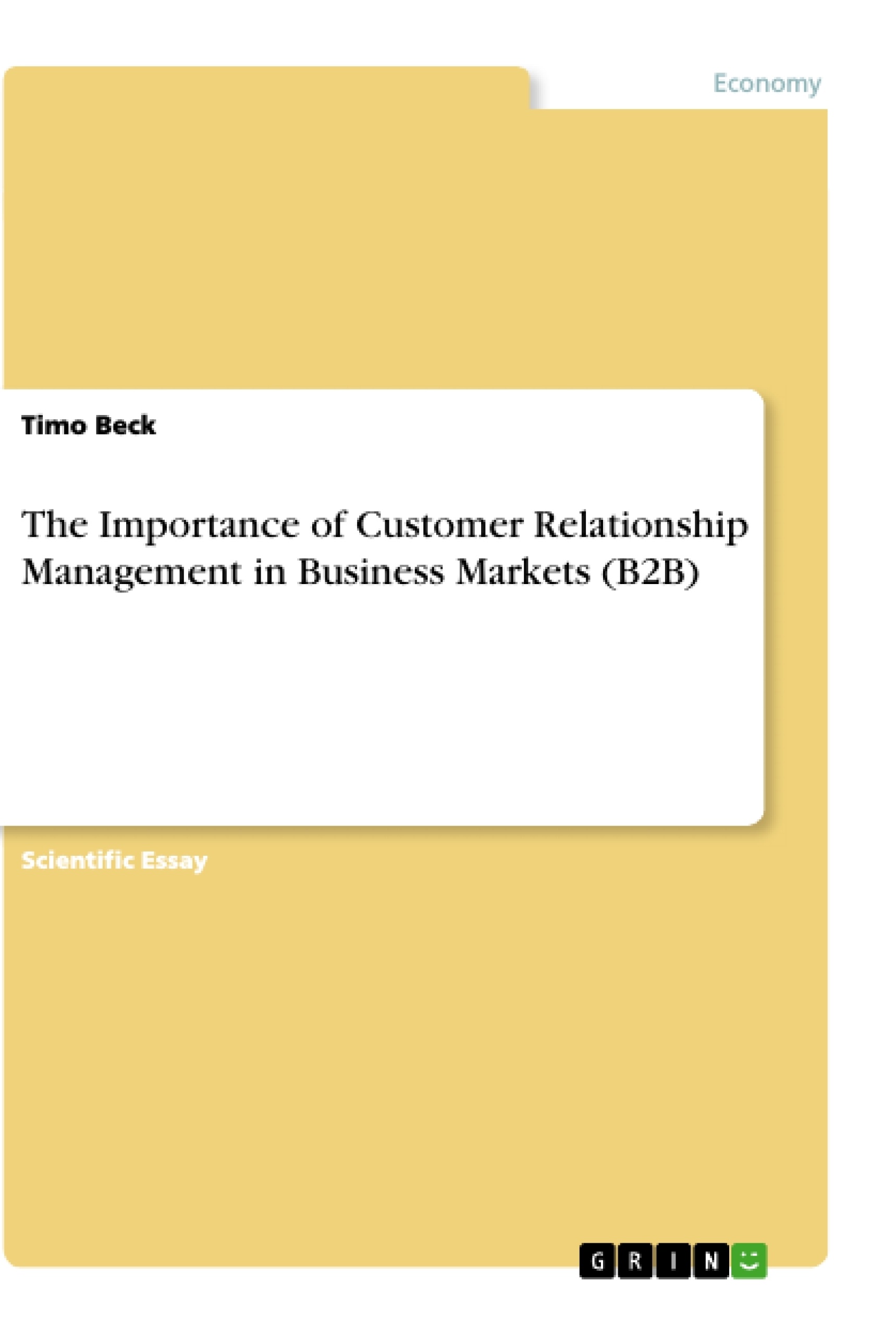The business-to-business (B2B) landscape is rapidly changing due to a variety of trends: The evolving end-customer expectations drive companies to be more responsive and provide a better value-proposition to their customers. This has translated into business markets, demanding greater responsiveness, reliability, and quality consciousness from supplying firms (Sheth & Shainesh, 2001: 274).
Market consolidation as a result of a wave of mergers and acquisitions in many industries during the past two decades forces many companies to focus on the few large customers that survived (Narayandas, 2003: 1). Globalization, hyper-competition, the rapid rise of information technology, and the commoditization of many products through e-commerce have resulted in better visibility of demand and supply and lower switching costs. Logistics and communication advances have made buying from across the globe as easy as buying locally (Schäfer, 2007: 10).
All this has lead to an erosion of customer loyalty and the ability to seek lower priced, better quality options from a wide variety of suppliers instantaneously. Therefore, building customer loyalty through relationship management is not a choice anymore for most businesses; it is crucial for the achievement of sustainable competitive advantage (Sheth & Shainesh, 2001).
This report to the head of marketing of an imaginary business-to-business supplier aims to discuss the implementation of a customer relationship management (CRM) system. More specifically, the author will define the relevant terms, outline the suggested CRM techniques, and highlight their potential benefits and limitations. At the end, some final conclusions and recommendations will be presented.
Introduction
The business-to-business (B2B) landscape is rapidly changing due to a variety of trends: The evolving end-customer expectations drive companies to be more responsive and provide a better value-proposition to their customers. This has translated into business markets, demanding greater responsiveness, reliability, and quality consciousness from supplying firms (Sheth & Shainesh, 2001: 274). Market consolidation as a result of a wave of mergers and acquisitions in many industries during the past two decades forces many companies to focus on the few large customers that survived (Narayandas, 2003: 1). Globalization, hyper-competition, the rapid rise of information technology, and the commoditization of many products through e-commerce have resulted in better visibility of demand and supply and lower switching costs. Logistics and communication advances have made buying from across the globe as easy as buying locally (Schäfer, 2007: 10).
All this has lead to an erosion of customer loyalty and the ability to seek lower priced, better quality options from a wide variety of suppliers instantaneously. Therefore, building customer loyalty through relationship management is not a choice anymore for most businesses; it is crucial for the achievement of sustainable competitive advantage (Sheth & Shainesh, 2001).
This report to the head of marketing of an imaginary business-to-business supplier aims to discuss the implementation of a customer relationship management (CRM) system. More specifically, the author will define the relevant terms, outline the suggested CRM techniques, and highlight their potential benefits and limitations. At the end, some final conclusions and recommendations will be presented.
Customer Relationship Management in Business Markets
Definition of CRM
Over the past decade, there has been an explosion of interest in customer relationship management by both academics and practitioners. However, there remains a lack of agreement about what CRM really is and how CRM strategy should be developed (Payne & Frow, 2005). The term CRM emerged in the IT sector and is often used to describe technology-based customer solutions. In a more broad and strategic context, CRM can be defined as “…a combination of people, processes and technology that seeks to understand a company's customers. It is an integrated approach to managing relationships by focusing on customer retention and relationship development” (Chen & Popovich, 2003: 672). The term CRM is often used interchangeably with ‘relationship marketing’ in a marketing context (Parvatiyar and Sheth 2001). The below illustration shows a continuum of the different definitions of CRM; for the purpose of this report, the broad definition will be used.
illustration not visible in this excerpt
Figure 1: The CRM continuum; own illustration after Payne & Frow (2005: 168)
Types of Relationships
Although the development of close, positive relationships with customers is usually a desirable outcome of a CRM initiative, it is not always possible or appropriate. The type of relationship is dependant on market conditions, the purchase situation, the importance of the purchase and the preferences of the business marketer and the buying organisation. The purchases or exchanges line up along a continuum with one end a single transaction and the other a long-run, two-way collaboration (Day, 2000: 25):
illustration not visible in this excerpt
Figure 2: Relationship Spectrum; adapted from Day (2000: 25)
A business marketer usually manages a variety of relationships. In order to develop successful relationship marketing strategies, it must be decided which type of relationship matches which customer and secondly, appropriate strategies have to be designed respectively (Hutt & Speh 2007: 95). The following characteristics of relationships highlight the end points of the buyer-seller spectrum:
[...]
- Citation du texte
- Timo Beck (Auteur), 2010, The Importance of Customer Relationship Management in Business Markets (B2B), Munich, GRIN Verlag, https://www.grin.com/document/147717
-

-

-

-
Téléchargez vos propres textes! Gagnez de l'argent et un iPhone X. -

-
Téléchargez vos propres textes! Gagnez de l'argent et un iPhone X. -

-
Téléchargez vos propres textes! Gagnez de l'argent et un iPhone X. -

-
Téléchargez vos propres textes! Gagnez de l'argent et un iPhone X. -

-
Téléchargez vos propres textes! Gagnez de l'argent et un iPhone X.

